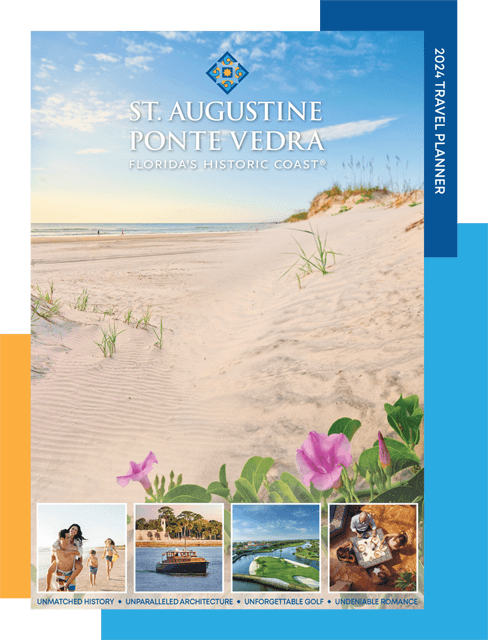Explore St. Augustine
St. Augustine is situated a mere 45 minutes from the glassy skyscrapers of downtown Jacksonville, 1 hour and 45 minutes from the rocket ships of Kennedy Space Center, and 2 hours from the fantasy theme parks of Orlando – but the city’s rich history and cultural diversity make it seem worlds away.
The city has more than 50 attractions including historical sites and points of interest, living history museums, animal parks, and ghost tours. Many are located within walking distance of one another in the downtown historic St. Augustine area, while others are in the uptown antique area or across the Bridge of Lions on Anastasia Island. Those are accessible via tourist transportation, making it possible to see it all without having to move your car!
Guided walking tours - as well as those by tram, trolley, horse-drawn carriage, or cruise boat - offer unique narratives of the story of historic St. Augustine, covering some of St. Augustine’s most popular landmarks.
Historical Sites
Must See Attractions
Parking in St. Augustine
Founded in 1565, the City of St. Augustine town plan was originally laid out in the late sixteenth century for foot traffic, walking, horses, and horse-drawn carriage. That's why the streets are so narrow, many of which are one-way, and many streets have overhanging balconies. Due to these historic roads, parking in downtown and the surrounding neighborhoods has always been at a premium.
The Historic Downtown Parking Facility (HDPF) is located at 1 Cordova Street, just off West Castillo Drive as you turn off U.S. 1, within walking distance to St. George Street and San Marco Avenue as well as the Castillo de San Marcos National Monument. The 4-story, 400,000 square-foot structure offers over 1100 parking spaces and is open 24 hours per day, year-round. It features daily pay on entry, security, and easy connections to sightseeing vehicles, and horse-drawn carriage services, and is located next to the Visitor Information Center. Parking at the HDPF is $20.00 per entry and is payable by cash or credit card. Locations, where the ParkStAug app may be used, do not include the HDPF. For more information about the HDPF, call (904) 484-5160.
The adjacent Visitor Information Center (VIC) has clean restrooms, a gift shop, lists of special events, arts and cultural information, and rows of brochures and guides. For more information about events, attractions, and the historic area, call the VIC at (904) 825-1000.
Parking in other City of St. Augustine-managed parking areas
Pay stations for parking are located throughout downtown St. Augustine. Easy-to-use directions are at each station and payable with cash, credit cards, or on the the ParkStAug app available from both the App Store and Google Play. Call 904-825-1037 for more information.
For more information on parking in downtown St. Augustine, please see the Parking Tips.
VisitStAugustine.com is an online visitor's guide for the nation's oldest city.
Some of the most up-to-date information can be found here, including some coupon codes if you book online!
If you are looking for specific information on what you can and cannot do in St. Augustine, visit the City of St. Augustine's website.
They have information regarding parking, the beaches, and all other ordinances available right at your fingertips.
They have details on just about everything, including the best hotels, places to eat, and things to do!
History of St. Augustine
St. Augustine, Florida, was founded by Spanish explorers long before Jamestown and the Plymouth Colony. Juan Ponce de Leon, the first governor of Puerto Rico, landed near present-day St. Augustine on Easter, March 27, 1513. He was in search of the legendary Fountain of Youth. Claiming the land for Spain, he named it “La Florida” for the many beautiful flowers in bloom.
Over the following half-century, Spain launched at least six failed attempts to establish an actual European settlement in this area of Florida, but it was the French who did it successfully. The French established a settlement with Fort Caroline along the area of high sand dune bluffs that overlook the St. Johns River in present-day Jacksonville. This new French colony not only posed a threat to the Spanish territorial claims, but also to the Spanish treasure fleets that sailed along the Florida coast.
When King Philip II of Spain heard that the French had made a settlement near the mouth of the St. Johns River in what he considered Spanish-claimed territory, he wanted them out immediately. As a result, the King named his country’s most experienced admiral, Pedro Menendez de Aviles, as the new governor of Florida and instructed him to not only colonize the area but to also drive out any settlers from foreign lands that he may encounter.
With 11 ships, Admiral Pedro Menendez set sail for Spanish Florida, and on September 8, 1565, he and his crew landed at an inlet in what would later become northeast Florida. Because Menendez sighted the spot on the Feast of St. Augustine of Hippo, the patron saint of his hometown, he named the settlement St. Augustine. The Timucuan Native American village of Seloy existed only a few miles away from the new Spanish settlement.
Admiral Menendez wiped out the French settlement at Fort Caroline, securing La Florida for Spain and the oldest continuous settlement in the United States, St. Augustine, Florida, would continue to grow.
History of St. Augustine
1513 Ponce de Leon lands near the site of St. Augustine and declares La Florida for Spain.
1565 Menendez establishes St. Augustine and drives the French out of nearby Ft. Caroline.
1586 English pirate Sir Francis Drake burns and pillages St. Augustine.
1668 Captain John Davis and his band of English buccaneers slaughter 60 townspeople in the streets and plunder their homes. Such clashes become increasingly common with the establishment of English colonies in Georgia and the Carolinas.
1672 Construction begins on St. Augustine’s famous coquina fort, the Castillo de San Marcos.
1696 The Castillo de San Marcos is completed. In its history, it never falls to any outside attacks.
1702 Governor James Moore of Carolina leads a two-month siege on the Castillo without success.
1740 British General James Oglethorpe of Georgia launches another unsuccessful attack on St. Augustine.
1763 After the French and Indian War, Spain trades Florida to Great Britain in exchange for Havana. St. Augustine comes under British rule for the first time.
1783 After maintaining its allegiance to Britain during the American Revolution, St. Augustine and Florida are returned to Spanish rule under the terms of the Treaty of Paris, signed between England, France, and Spain.
1821 A colorful ceremony in St. Augustine marks the peaceful transfer of power as Spain sells Florida to the United States. Spanish soldiers leave St. Augustine, never to return again.
1837 Osceola, famous leader of the Seminole Indians, is captured near St. Augustine and held prisoner for two months in the Castillo de San Marcos before being transferred to South Carolina. This occurs during the Seminole War, which carries on for much of Florida’s 24-year territorial period.
1842 The Seminole War ends in Florida with the surrender of much of the Seminole nation.
1845 Florida becomes the twenty-seventh state of the Union. Tallahassee is selected as the capital due to a geographical compromise between St. Augustine and Pensacola. Tourism also begins to take hold at this time.
1862 During the Civil War, a Union blockade appears off the city’s inlet and demands the surrender of St. Augustine. That night Confederate troops retreat and the Union occupies the city through the end of the Civil War in 1865.
1883 The Jacksonville, St. Augustine & Halifax River railway is completed, linking St. Augustine with its booming neighbor to the north, Jacksonville. During the winter of 1883-1884, Henry M. Flagler, the co-founder of the Standard Oil Company, visits St. Augustine and is amazed by its charm and tourism potential.
1883 Henry Flagler’s two magnificent hotels, the Hotel Ponce de Leon (now Flagler College) and the Alcazar Hotel (now houses the Lightner Museum) open for an elite tourist clientele. He also purchases the Cordova Hotel (now the Casa Monica). The three hotels make St. Augustine a magnet for high society travelers, earning the city the nickname “Newport of the South.”
1896 Flagler’s East Coast Railway reaches Miami, opening the door to developing South Florida.
Today, St. Augustine remains a popular international tourist destination, retaining a unique mix of small-town charm, southern hospitality, historical integrity, and seaside appeal!




